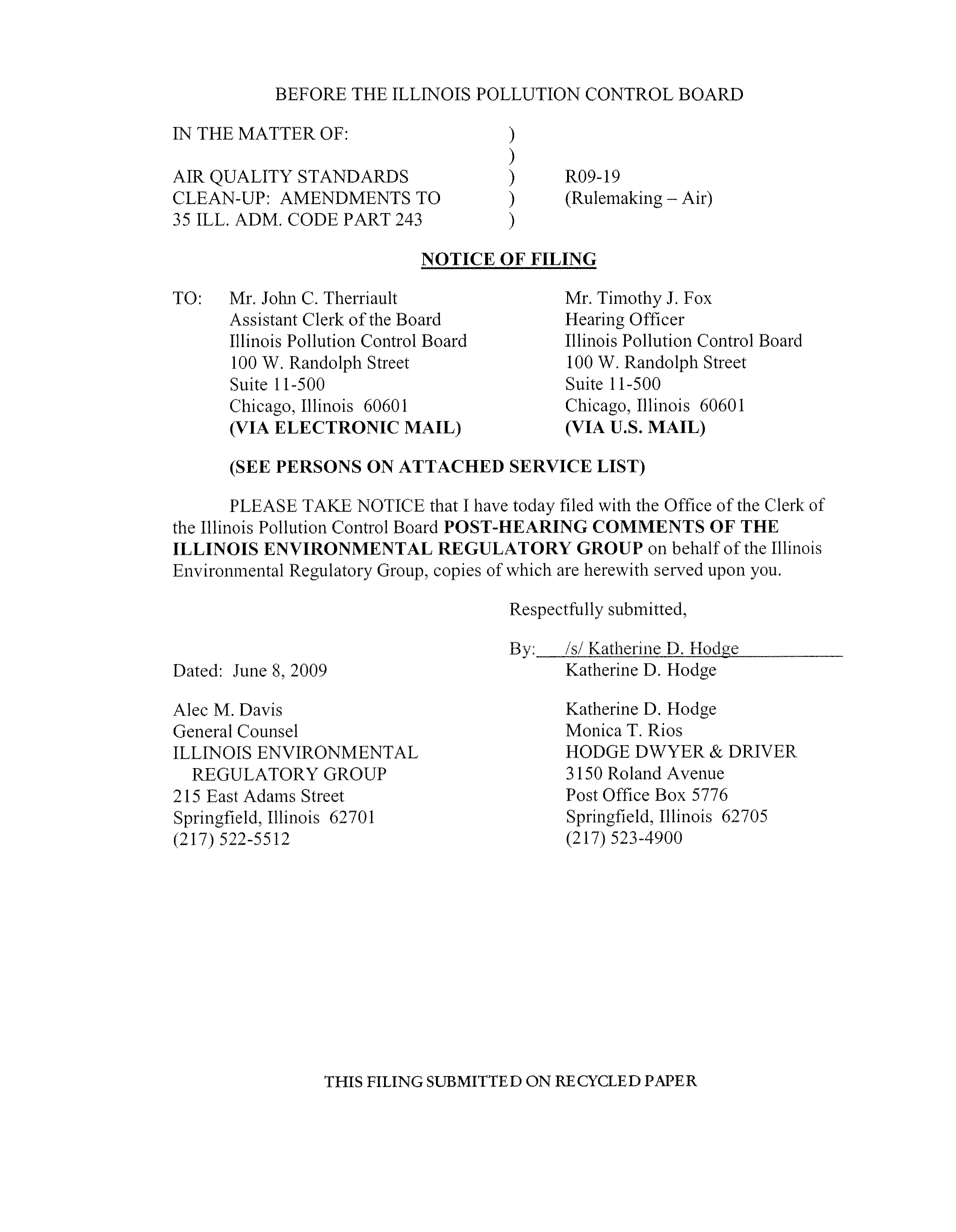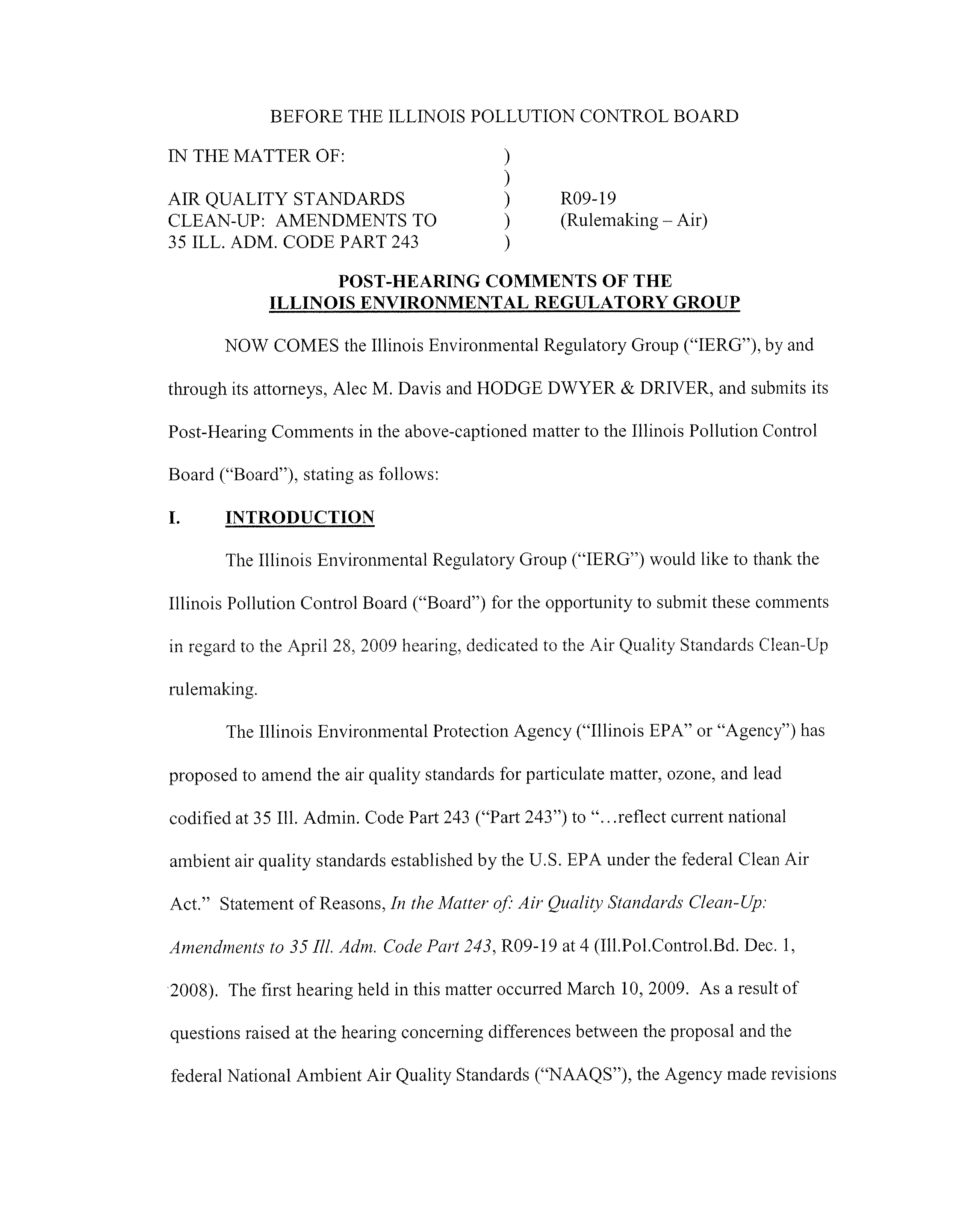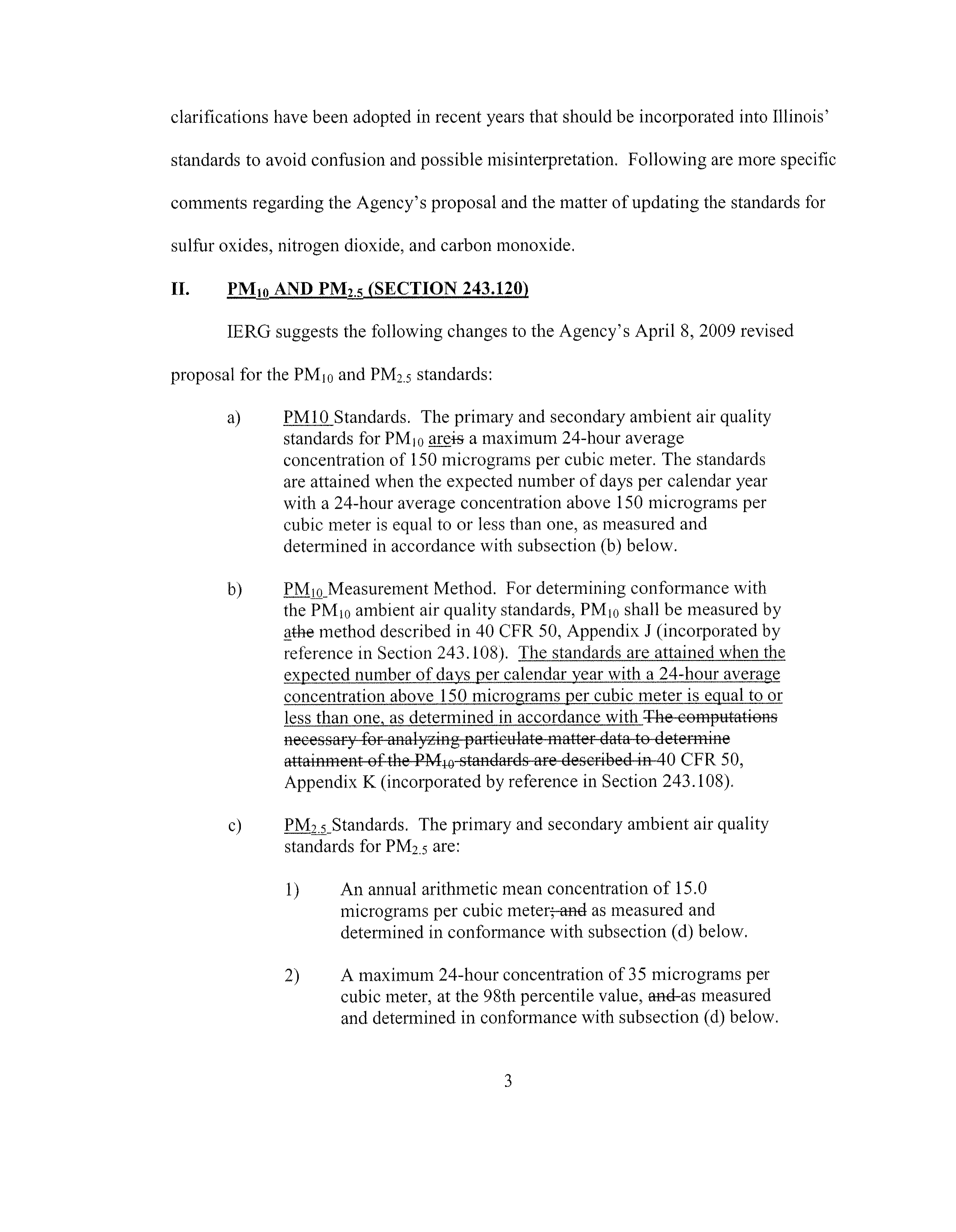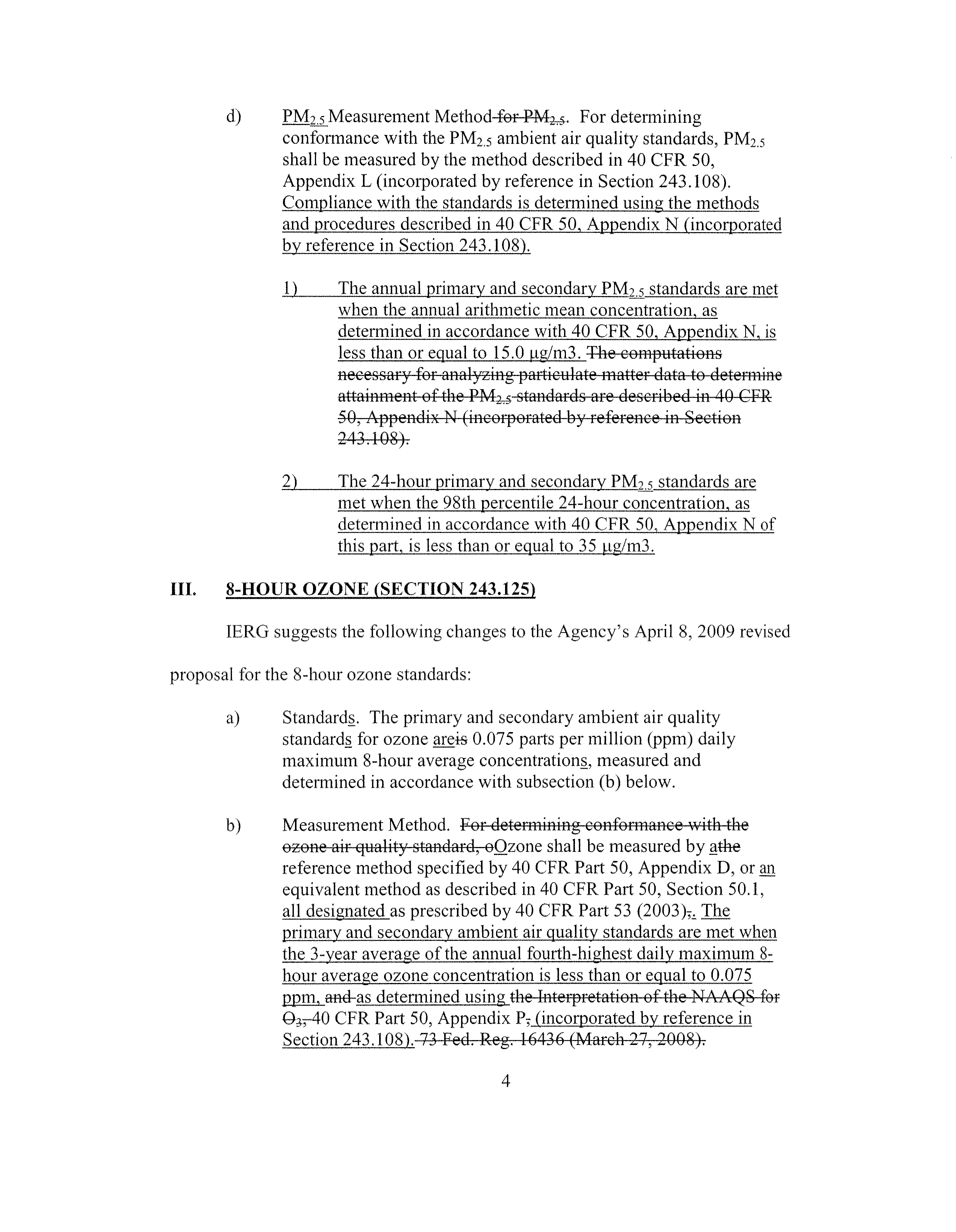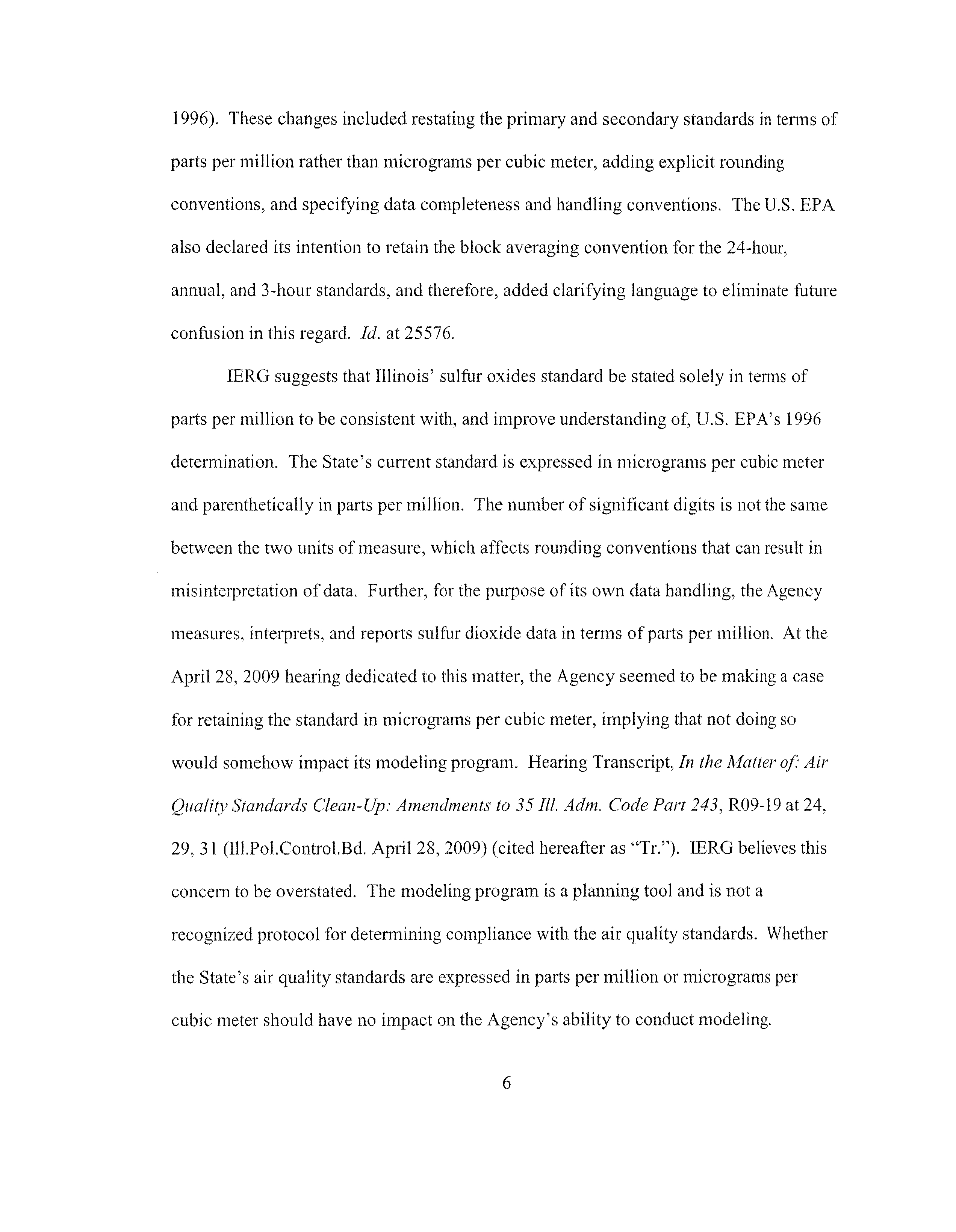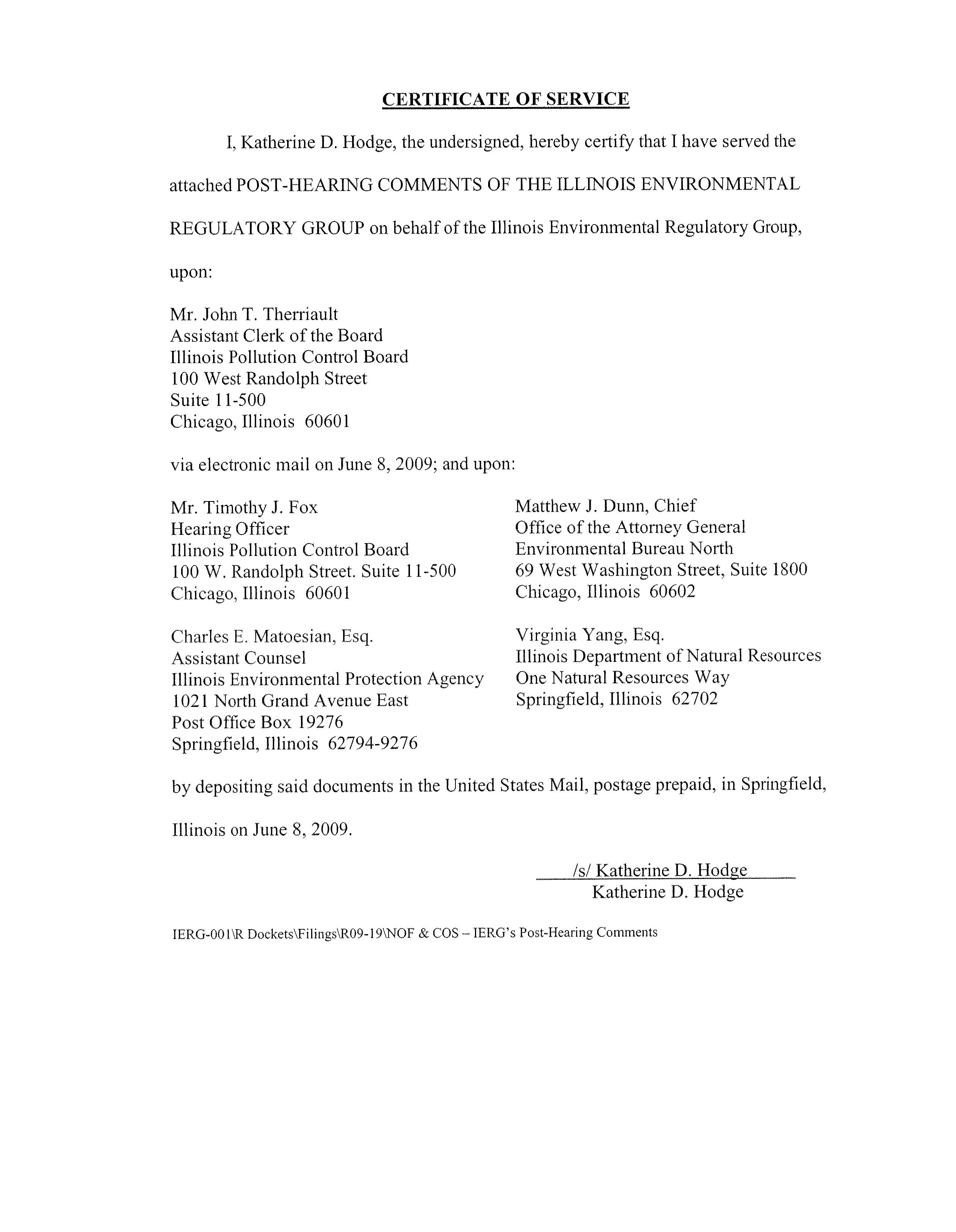INOIS POLLUTION
CONTROL BOARD
F:
AIR QUALITY STANDARDS
CLEAN-UP: AMENDMENTS TO
. CODE PART 243
}
R09-19
}
(Rulemaking - Air)
NOTICE OF FILING
TO: Mr. John C. Therriault
nois
11-500
istant
Clerk
of the Board
Illinois Pollution Control Board
100 W. Randolph Street
Hearing Officer
nois Pollution Control Board
100 W. Randolph Street
to 11-500
Chicago,
Illinois 60601
IL)
ICE LIST)
CE that I have today filed with the Office of t
ois Pollution Control Board POST-HEARING COMMENTS O
LINOIS ENVIRONMENTAL REGULATORY GR
Environmental Regulatory Group, copies
of which are herewi rved upon you.
itted,
Dated: June 8, 2009
By.
D. Plod
Alec M. Davis
Katherine D.
General Counsel
Monica T. Rios
AL
DGE DW
3150
Roland Avenue
215 East Adams Street
Post Office Box 5776
ois
62701
7) 522-5512
(217) 523-4900
ois 62705
THIS FILING SUBMITTED ON RECYCLED
PAPER
Electronic Filing - Received, Clerk's Office, June 8, 2009
* * * * * PC #2 * * * * *
POLLUTION CONTROL BOARD
IN THE MATTER OF:
)
UALITY STANDARDS
CLEAN-UP: AMENDMEN
35 ILL. ADM. CODE PART 243
O
)
)
)
POST-HEARING COMMENTS OF THE
NOIS ENVIRONMENTAL
REGULATORY
GROUP
NOW COMES the Illinois
through its attorneys, Alec M.
Davis and HODGE DWY
Post-Hear
IVER, and submits its
nts in the above-captioned
matter to the Illinois Pollution
Control
"Board"), stating as follows:
ON
me
Board
rds Clean-
The Illinois Environmental
Protection Agency ("Illinois EPA"
proposed to amend the air qu
ambient air quality standards established lay the
Statement of
Reasons, In the Matter of Air Quality Standards Cyan-Up;
An2endinents to 35 Ill. A(hn. Code rt 243, R09- 9
at 4 (II1.Pol.Co
2 008). The first hearing held
in dais matter occurred March 10, 2009.
quest
ironmental Regulatory Group ("IERG°'), by
and
R09-19
(Rulemaking - Air)
"IERG") would like to thank the
oard") for the opportunity to submit these comments
andards for pa
gency") has
ead
n. Code
Part 243 ("Part 243") to "...reflect current national
earing conce
esult of
rences between the proposal and the
r Quality Standards (`
the Agency
made revisions
Electronic Filing - Received, Clerk's Office, June 8, 2009
* * * * * PC #2 * * * * *
on
April
8,
2009 to more
precisely
conform its proposal to the form and substance of the
United States Environmental Protection Agency's ("U.S. EPA") NAAQS. IERG
su
s the des
substance to the NAAQS.
adopted on April 30, 1971, the Illinois E
and the Board have expressed the intent to adopt
I
identical to the NA
Standards
among other things, concluded the
following:
state and federal standards is obviously desirable
to adopt standards in Illinois that are identical in
ois Standards
that are substantively
S. In the Board's opinion in In the .Matter (?f
Proposed
Air
Quality
72-7), adopted on July 10, 1975, the Board discussed the need for statewi
disagreemet
achieving
federa
In light of the above considerations, the PCB today
is
proposing
adoption
of the federal standards.
," Board Newsletter #47, cited in
In
the
Matter
of
Proposed Air Quality Standards, R72-7 at 4-5 (111.Pol.Control.Bd.
July 10, 1975).
The Board then proceeded
to adopt the federal
The proposal by the Agency
aking appears to continue the espoused
o maintain
uniformity between state and federal standards, "...unless
there is solid
ground for disagreement..." IERG supports the
Agency's proposal, but would
encourage the Agency
and the Board to take this opportunity to update the standards
for
oxides, n
on
monoxide as well.
standards for sulfur oxides,
nitrogen dioxide, and carbon
monoxide have not been substantively
revised by the U.S. EPA, but
Electronic Filing - Received, Clerk's Office, June 8, 2009
* * * * * PC #2 * * * * *
clarifications have been adopted in recent years that should be incorporated into Illinois'
standards to avoid confusion and possible misinterpretation. Following are more specific
comments regar
the
Agency's proposal and the matter of updating the standards for
sulfur oxides, nitrogen dioxide, and carbon monoxide.
SECTION
243.120`1
IERG suggests the following changes to the Agency's April 8, 2009 revised
proposal for the P
and PM,.5 standards:
PM10 Standards. The primary
and secondary ambient air quality
standards for PM, o arei-s a maximum 24-hour average
150 micrograms per cubic meter. The standards
the expected
number of days per calendar year
with a
24-hour average concentration above 150 micrograms per
equal to or less than one, as measured and
ining conformance with
o shall
be
rporated by
1
of days per calendar year wi
ed when the
ge
concentration above 150 micrograms per
cubic
less than one, as determined
in accordance with
_.5_Standards.
The primary and secondary
ambient air qua
standards for PM2 5 are:
1)
An annual arithmetic mean concentration of 15.0
micrograms per cubic meter;-ate as measured
and
determined in conformance with subsection
(d) below,
centration of 35
micrograms per
il
Electronic Filing - Received, Clerk's Office, June 8, 2009
* * * * * PC #2 * * * * *
d) PM2,5 Measurement
Method: f&r-P-M25. For determining
conformance with the PM2,5 ambient air quality
standards, PM2.5
shall be measured by the method described in 40
CFR
50,
ndix L (incorporated by reference in Section 243.108).
liance with the standards is determined
using the methods
procedures described in 40 CFR 50, Appendix
N
incorporated
reference in Section
243.108).
ry and secondary
PM?-5
standards
are met
less than or equal to 15.0
L!gl
when the annual arithmetic mean concentration as
determined in accordance with 40 CFR 50, Ap endix
24-hour primary and secondary PMZ25 standards are
98th percentile 24-hour concentration, as
determined in accordance with 40 CFR 50, Appendix N of
les
11.
2009 revised
proposal for the 8-hour ozone standards:
Standards. The primary
and
secondary
ambient air quality
standards for ozone areiý 0.075 parts per million (ppm) daily
oncentrations, measured and
determined in accordance with subsection (b) below.
Measurement Method.
reference method specified by 40 CFR Part 50, Appendix D, or an
ethod as described in 40 CFR Part 50, Section 50.1,
cribed by 40 CFR Part 53 (2003),. T
ondary ambient air quality standards are met when
Ozone shall be measured by athe
the 3-year
average of the annual fourth-highest daily maximum 8-
hour average ozone concentration is less than or equal to 0.075
pnm,_and-as determined usin
0-3=,40 CFR Part 50, Appen
Section 243.108
Electronic Filing - Received, Clerk's Office, June 8, 2009
* * * * * PC #2 * * * * *
LEAD (SECTION 243.126)
IERG suggests the following changes to the Agency's April 8, 2009 revised
he lead standards:
a)
b)
standards for lead and its
compounds
arei-s 0.15 micrograms per
cubic
meter, maximum arithmetic mean over a rolling three
calendar month eý riod ra-ge measured and determined over a
three year period.
ary and secondary ambient air quality
Measurement Method. For determining conformance with the
uality standards for lead and its compounds,
lead and
ds shall be measured
by a reference method based on
on 243.108 of this P
secondary ambient air quality stan
ndix Rsha4be
3 as
by
for a 3-year
0.15 micrograms per cubic meter as
°ithmetic 3-month
mean concentra
ion 243.108 of this Part).
The current sulfur oxides
standards in Section 243.122 were adopted by the
Board
on July 10, 1975, and according to the Board,
t
federal standards." Board Opinion,
In the Matter
R72-7 at 14.
The
EPA
has reviewed and revised the cri
re "....identical to the
ed Air
ands,
is upon which
its
sulfur
oxides
air quality standards are based and
has determined that revisions of the standards were
not warranted,
other than several minor technical changes. 61 Fed.
Reg. 25566 (May 22,
Electronic Filing - Received, Clerk's Office, June 8, 2009
* * * * * PC #2 * * * * *
1996). These changes it
parts per million rather than
conventions, and speei
d secondary standards in terms of
grams per cubic meter,
adding explicit rounding
completeness and handling conventions. The U.S. EPA
also declared its intention to retain the block averaging convention for the 24-hour,
annual, and
3-hour standards, and therefore,
added
clarifying language to eliminate future
confusion
suggests that
Illinois' sulfur
oxides
standard
be stated solely
egard. Id. at 25576.
parts per million to be consistent with, and improve understanding of, U.S. EPA's 1996
determination. The State's current standard is expressed in micrograms
and paren
ubic meter
n parts per
million. The number
of significant digits is not the same
between the two units of measure, which affects rounding conventions that can
rpretation
of data.
Further, for the purpose of its own data handling, the Agency
measures,
and reports sulfur dioxide data in terms of parts per trillion, At the
Matter, the Agency seemed to be making a case
the standard in micrograms per cubic meter, implying that
not
doing so
would
somehow
impact its
t, In the Matter of Air
lity Standards Clean-Up:: Amendments to 35
Ill. Adrn.
Code.Part
243, R09-19 at 24,
29,31
rol.Bd. April 28, 2009) (cited hereafter as "Tr."). IERG believes this
concern to be ove
recognized protocol for dete
modeling program is a planning tool and is not a
mpliance with the air quality standards. Whether
the State's air quality standards
are expressed in parts per million or micrograms per
eter should have no impact on the
Agency's ability to conduct modeling.
Electronic Filing - Received, Clerk's Office, June 8, 2009
* * * * * PC #2 * * * * *
Similarly, IERG believes that Illinois needs to clearly
address
riding
convention
ounded up) - is applicable to the primary annual sulfur oxide NAAQS. 40
convention - to three decimal places (fractional parts equal
to or greater than 0.0005 ppm
C.F.R. 0.4(a) (2008); see also 40 C.F.R. §§ 50.4(b), 50.5(x). Illinois'
adoption of the
sulfur oxides rule. The U.S. EPA has amended its rule to clarify that the
same clarification will not only help avoid confusion,
but
it
will also result in the
codification of the method the Agency currently uses.
The U.S. EPA has ovided further clarification in the sulfur
oxides NAAQS by
ess and data handling criteria. For example, the
specifies that at least 18 of 24 hourly values must be available to compute a 24 hour
average. 40 C.F.R. § 50.4(4). It further specifies
how
missing data a
led. Id. IERG understands that the Illinois
dard would simply
IERG encourages the Agency and the
de the U.S. EPA's data com teness and data handling criteria into the
In the November 15, 1994 Federal Register Notice reproposing the sulfur oxides
standard, the U.S. EPA addressed the
issue
of
block averages versus
running averages for
the 3-hour, 24-hour and annual standards. 58 Fed. Reg. 58958 (Nov. 15, 1994). In
ed:
Although the wording of the original 24-hour, 3-hour, and arm
standards was ambiguous on the matter, the earliest actions of the EPA.
signify that
the block averaging convention was intended for these
Electronic Filing - Received, Clerk's Office, June 8, 2009
* * * * * PC #2 * * * * *
standards (OAQPS,1986), and block averages have generally been used in
ing the standards.
.S. EPA then stated, "[t]o eliminate any future questions on this aspect of the
uage is being proposed in the regulation (40 CFR 50.4 and
50.5)." Id. The NAAQS now reads, in part: "[t]he 24-hour averages shall be determined
from successive nonoverlapping
24-hour blocks starting at midnight each calendar
day...." 40 C.F.R.
§
50.4(b). The standard similarly defines
the averaging periods for
the annual and 3-hour standards.
EPA also explicitly recognized that "the
use
of
the alternative, running averages, would
represent
that the
wor
block-averaging convention, the U.S.
61 Fed. Reg. at 25576.
e State's su
s. Mr. David
Kolaz, testifying on behalf of IERG at the Apri
28,
2009
hearing, stated that the Illinois EPA has been interpreting the State standard as
based on a running average time period, while the U.S.
using block
averages. Tr. at I I-14, Ex
David
2 and 3; see also Pre-Filed Testimony of
the Matter of
Air Quality ý tandards Clean-Up: Anzendrnents to 35 Ill.
Adrn. Code Part 243, R09-19 at 2-3 and Attachment
1 (111.Po1.Control.Bd. April 14,
ony"). At
hearing, the Illinois EPA seemed to s
discrepancy was irrelevant, as states are permitted to
have standards stricter than the
0
and 25-26. IERG does not deny that this is the case.
However, upon review of the Board records
relating to the Illinois sulfur oxides standard,
IERG
has
been
unable to locate any instance where the Illinois EPA stated
was to have a standard for sulfur oxides
that is
ent
g ent than the federal standard.
Electronic Filing - Received, Clerk's Office, June 8, 2009
* * * * * PC #2 * * * * *
Nor is there any apparent record of
justification for such a more stringent standard.
Rather, as described above, the promulgation of the State
based on being
standard was
ical to that of the U.S. EPA. Because U.S.
EPA's standard is based
on a block average interpretation,
IERG suggests that Section 243.122 be amended
accordingly to remove
the ambiguity. In the alternative,
should the Agency not concur
change to a block averaging
interpretation, it should be prepared
to justify the
need for a more stringent
state than federal standard.
VI.
ION 243.124)
for nitrogen
1985. 50 Fed.
rounding conve
g. 25544
d handling methodologies similar
in
greater detail above
for sulfur oxides. The standard is al
pillion and stated parenthetical
meter.
illion standard,
the U.S. EP
.053, instead of 0.05, parts
per million.
olaz
on behalf of
er million as the State standard
in its
quality reports. Tr, at
29; Kolaz Testimony at 4-5.
Accordingly, IERG
recommends that the Agency
and the Board modify
Illinois' codified nitrogen
dioxide
tly 0.05 ppm) to
conform to the NAAQS.
IERG would
recommend that the State
standard not
the micrograms per cubic
meter
parenthetical, as it does nothing
to add clarity. The
lack of need
June
19, 1985). The standard
includes block averaging,
sio
Electronic Filing - Received, Clerk's Office, June 8, 2009
* * * * * PC #2 * * * * *
parenthetical micrograms per cubic meter is further supported
by the U.S.
EPA's
pra
to not express the standards in both parts per million an
gaseous pollutants since the
time
the nit
s
ubic meter for
ide NAAQS was last
updated.
For
example, the 1-hour NAAQS ozone standard was stated in parts per million and
parenthetically in micrograms per cubic meter when it was published in 1979. 44 Fed.
Reg.
8202.
The
8-hour
NAAQS ozone standard published
on
July 18, 1997 was
expressed solely in parts per million. 62 Fed. Reg. 38856. Also, as mentioned ear
the
sulfur oxides standard
revised
on
May 22, 1996 was expressed of
per million. 61 Fed. Reg. 25566. The latest ozone standard adopted on March 27,
2008
ed only in parts per million. 73 Fed. Reg. 16436. Clearly, the U.S. EPA is
g attention to reliance on the "parts per million"
nomenclature. For Illinois to
delete the micrograms per cubic meter reference for nitrogen dioxide will not create a
substantive
inconsistency between the State and
OXIDE (SECTION 243.123)
oxide NAAQS in 1985,
choosing to express the standard in parts per million and parenth
cubic
meter. 50
Fed. Reg. 37501 ept. 13, 1985). This is t
currently expressed in the State standard.
sta
of the way
it
hat time, the
U.S.
EPA also updated the
e data completeness and handling criteria. Nothing was stated
about
block averages, but the U.S. EPA uses
a running non-overlapping approach to
interpreting compliance
our standard. IERG advocates expressing the
carbon
monoxide standard solely
in terms of parts per million for the reasons spec
10
Electronic Filing - Received, Clerk's Office, June 8, 2009
* * * * * PC #2 * * * * *
ions of sulfur oxides and nitrogen
dioxide. We also suggest that the
rounding convention and data completeness
and data handling components
of the U.S.
rporate
stly, we believe
that the State rule should also specify
that
the 8-hour standard is determined
using non-overlapping
running averages.
V1
CL
ports the efforts of the
Agency to update the State's air
standards. This effort,
however, should be extended beyond
the Agency's initial
proposal to include
clarifications to Illinois'
sulfur oxides, nitrogen dioxide, and carbon
11 afford
the public and regulated
community a much clearer
uality
standards.
will then more accurately
reflect t
thods and to
interpret
the standards, with one exception.
Unlike its current practice
of interpretir
standard
on a running average basis,
the Agency will need to adopt
the
block
averaging approach.
Electronic Filing - Received, Clerk's Office, June 8, 2009
* * * * * PC #2 * * * * *
G offers these comments
to facilitate achieving the intent of the proposed
rovide conformity
ois' and the U.S.
EPA's standards, as
stated lay the Board at the time
the
State's
standards were
lly adopted RG
appreciates the opportunity to comment.
may arise.
ill be pleased
to answer any questions that
Respectfully submitted,
REGULATO
ILLINOIS ENVIRONME
Dated: June 8,
2009
By:
/s/Alec M. Davis
One of Its Attorneys
Post Office Box 5776
gfield, Illinois 62705
)523-4900
I ERG-00 I/R
Dockets/Pitings/R09-L9/IERG's Post-Hearing
Comments
Electronic Filing - Received, Clerk's Office, June 8, 2009
* * * * * PC #2 * * * * *
E Old` SERVICE
Hodge, the undersigned, hereby certify that
I have served the
attached
POST-HEARING COMMENTS OF THE ILLINOIS ENVIRONMENTAL
OU
u pon:
on behalf of the Illinois
Environmental Regulatory Group,
Mr. John T. Therriault
stant Clerk of the
Board
Illinois Pollution Control Board
100 West Randolph Street
via electronic mail on June 8, 2009; and upon:
othy J. Fox
Matthew J.
Dunn, Chief
g Officer
Office of the Attorney General
100
W. Randolph Street.
r
to 11-500
Chicago,
Illinois 60602
mental Protection Agency
1021 North Grand
76
gfield,
Illinois 62794-9276
by deposit
Illinois on
June
documen
62702
ge prepaid, in Springfield,
gton Street,
of Natural Resources
ounces Way
a
I ERG-001\R DocketsTilings\RQ9-19NOF & COS-IERG's
Post-Hearing Comments
Electronic Filing - Received, Clerk's Office, June 8, 2009
* * * * * PC #2 * * * * *
